 This year's 3-D Christmas tree cookie* was inspired by a project that my kids made in elementary school: a Christmas tree composed of stacked cardboard tubes (like those inside rolls of paper towels), all stapled together. Here, I made thick cookie rings and baked them close together so they would fuse into a sturdy structure. I then flooded this fused structure on both sides, and hung a heart-shaped royal icing transfer within each ring. The little hearts are “glued” to strips of wafer paper so everything in this project is edible! I originally intended to use mini cookies for the hearts, but the transfers gave a lighter look to the final structure.
This year's 3-D Christmas tree cookie* was inspired by a project that my kids made in elementary school: a Christmas tree composed of stacked cardboard tubes (like those inside rolls of paper towels), all stapled together. Here, I made thick cookie rings and baked them close together so they would fuse into a sturdy structure. I then flooded this fused structure on both sides, and hung a heart-shaped royal icing transfer within each ring. The little hearts are “glued” to strips of wafer paper so everything in this project is edible! I originally intended to use mini cookies for the hearts, but the transfers gave a lighter look to the final structure.
* Last year around this time, I also made a 3-D Christmas tree cookie, which you can read all about here. And, while on the subject of other 3-D Christmas tree cookies, please also take a look at these stunning creations by Hani Bacova (aka @Hani/Haniela's), Rebecca Weld (aka @RebeccArchitect), and Rosemary Ann of Sweet Kissed Confections (aka @Rosemary Ann).
Now, back to this project!
- Cookie dough of your choice
- 1 (4 1/8 x 2 3/4-in/10.5 x 7-cm) oval cookie cutter (I used the third largest one in this nesting set of six cutters.)
- 1 medium (2 3/8-in/6-cm) round cookie cutter
- 1 medium-small (1 5/8-in/4-cm) round cookie cutter
- Royal icing and piping tips:
- White piping-consistency with equivalent of PME #1 tip
- Grey flooding-consistency with equivalent of Wilton #2 tip
- Red medium-consistency with equivalent of PME #2 tip
- White very thick-consistency with parchment cone (@Julia M. Usher calls it “glue”; see her video for reference.)
- Wafer paper
- Scissors
- Scribe tool
- 20 small (3/4-in/2-cm) heart-shaped royal icing transfers (A royal icing transfer is royal icing piped off the cookie directly on another surface, such as parchment paper or acetate. The icing is allowed to dry and then later transferred onto a cookie or used as a standalone decoration, as I did here.)
Step 1: Roll, cut, and bake cookies
a. Roll out your dough to a thickness of slightly more than 3/8 inch (1 centimeter). Cut out an oval, and use the two round cookie cutters to cut out 10 rings. Arrange the rings in four lines to form a tree. (Well, I see a tree, but it is really a triangular shape.) Do all of your arranging directly on parchment paper or a baking mat, so that the parchment paper/mat can later be lifted (with the rings on top) and set directly on a cookie sheet for baking. This process, as well as using well-chilled dough, will minimize any distortion of the rings that can come from handling them.
b. Move the rings close together, making sure that each ring touches the rings next to it. Once in the oven, the cookies should fuse together to become a single cookie structure.
Bake the cookies according to your recipe. Let them cool completely without moving the structure from the parchment paper or baking mat. (It's best not to move the structure until it has been flooded and that icing has completely dried, as the seams between the rings are fragile and prone to breaking apart.)
Step 2: Decorate back of structure, and flood oval base
a. Using white piping-consistency royal icing and a PME #1 tip (or equivalent), outline the structure, leaving spaces between adjoining circles as shown below.
b. Flood the interior with grey flooding-consistency royal icing and a Wilton #2 tip (or equivalent). The aim is to cover all the seams between each ring in order to reinforce the structure. Let the icing dry about 8 hours at room temperature, or accelerate the process in a food dehydrator. The structure will be flipped over in Step 3, so the icing on this side must be completely dry. Again, to avoid breakage, it's best not to move the structure while it is drying and/or to support it by setting it on a cookie sheet or piece of cardboard.
c. Now, with the same white icing and tip used in Step 2a, outline the oval cookie, as well as two rectangles within the oval. The two rectangles should be spaced at a distance equal to that between the two central rings at the bottom. As a reference, the rectangle width should be about 1.5 centimeters (5/8 inches) - roughly the thickness of the cookie plus two iced surfaces. Its length should be just a little bit larger.
d. Using the same gray icing and tip used in Step 2b, flood the cookie, leaving the rectangles free of icing to create two holes or "pockets". These pockets will serve as a "nesting" area for the two central rings, and will give the tree more stability during the assembly process. Let the icing dry completely.
e. Cut ten strips of wafer paper, each about 4 x 0.4 centimeters (1 1/2 x 3/16 inches).
f. Stick one strip to the top of each ring, in the orientation shown below, using a dot of very thick white icing as “glue”. Let the icing dry completely.
Step 3: Decorate front of structure and oval base
Carefully flip over the cookie tree, and repeat Steps 2a and 2b for the other side.
a. Once the icing has dried completely, pipe an outer and inner border along the edges of every ring, using white piping-consistency royal icing and a PME #1 tip (or equivalent). The aim is to highlight each cookie ring in the structure. Pipe a small bead and move along the edge while releasing pressure to create a tail on the bead. Move the tip slightly back along the edge to cover some of the tail just piped, and pipe another bead and tail. Continue piping beads and tails in this way (short back-and-forth movements) until you complete a border along each edge.
b. Now, randomly pipe some dots, like snowflakes, on each ring.
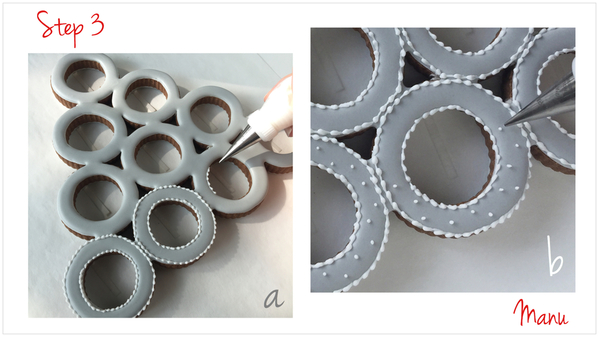
Prepare 20 (3/4-in/2-cm) heart-shaped royal icing transfers, using red medium-consistency royal icing and a PME #2 tip (or equivalent). Add a white teardrop accent to the upper left lobe of each heart, and let the transfers dry completely. For more information about making transfers, see Step 4 of my previous Christmas tree tutorial here.
c. Pipe a dab of icing “glue” on the back side of two heart transfers.
d. With the help of a scribe tool, lift a wafer paper strip and place a transfer, glue side up, in the middle of the ring underneath the free end of the strip.
e. Release the wafer paper strip, and press its end into the icing; then place the other transfer on top, like a sandwich.
f. Gently push the heart transfers together with your finger tip, or with the soft gummy end of a scribe tool, to make sure they are firmly attached to one another.
Repeat Steps 3c to 3f for each of the remaining rings.
g. Now, for the oval base! Use white piping-consistency royal icing and a PME #1 tip (or equivalent) to pipe a border along the edge of the oval. Rather than piping a border in one direction all the way around, pipe the border in quadrants so the border appears symmetrical from all angles. Refer to the diagram below for the starting points for piping (flat ends of arrows) and piping directions in each quadrant. Then pipe a beaded border along the four edges as described in Step 3a. Use red medium-consistency royal icing and a PME #2 tip (or equivalent) to pipe two little hearts as accents where the borders meet on the two long sides.
h. (Optional) I later decided to cover the ends of each wafer paper strip by piping little hearts like the ones on the base. To do so, be sure the icing decorations made in Steps 3a and 3b are completely dry; then flip over the cookie. Set it on a soft mat to avoid damaging the decorations on the underside; then pipe away! Alternatively, pipe these hearts after Step 2f to avoid flipping the structure again!
Step 4: Assemble tree
a. Pipe two blobs of white royal icing “glue” in the pockets on the base.
b. Lift the structure and center it in the holes on the base. Make sure the tree is both perpendicular to the base and not leaning to the left or to the right . . . mine does, but I figured this out too late after the glue was already dry!
c. Use a scribe tool to remove the excess icing along the seams, as shown to the left in the picture below. I only had icing to remove on the back side, but you may have to clean up both sides of the tree. Next, pipe a border at the base of the two central rings, only on the back side of the tree. Use white piping-consistency royal icing and a PME #1 tip (or equivalent), and pipe a border similar to the others already piped, or do as I did and pipe shorter tails between each bead (as shown to the right).
d. Because of the "pockets" we created, the cookie should stand by itself without props, but I recommend propping it for added stability. I used the handles of two mugs for props, but get creative with whatever you have on hand! Of course, avoid moving the tree until the icing at the base is completely dry.
And - ta da! Here is the completed project! I see an untraditional Christmas tree - quite minimalist with a subtle winter wonderland theme. Though, with all its hearts, it could also make a lovely Valentine's Day centerpiece!
And this is a picture of the back side.
Below is another version. I kept the concept of the stacked rings, but I flooded only one side of the structure. In each of the rings, I nestled a cross-stitched cookie letter to spell “Christmas” across the tree. As in my other "embroidery hoop"-style projects, I used @SugarVeil's Needlepoint Mat and Confectionery Icing to create the grid into which I piped the cross-stitch pattern. A SugarVeil® grid eliminates the task of piping the grid by hand, and is truly a genius idea! (Thanks to Michele Hester of SugarVeil® for first conceiving of this mat and this technique, now nearly three years ago!) To learn more about how I make these “embroidery hoop"-style cookies, see my past tutorial here.
P.S. I also had fun cross-stitching the word “Merry” on a real (non-cookie) embroidery hoop to match the cookie tree.
Happy cookie decorating!
Ciao,
Manu ❤️


Photo and cookie credits: Manuela Pezzopane
Note: Made by Manu is a Cookie Connection blog feature written by Manuela Pezzopane, where each month she shares the method behind a magical cookie of her own making. This article expresses the views of the author, and not necessarily those of this site, its owners, its administrators, or its employees. To read all of Manuela's past Made by Manu tutorials, click here. And to see all of Cookie Connection's tutorials, click here.



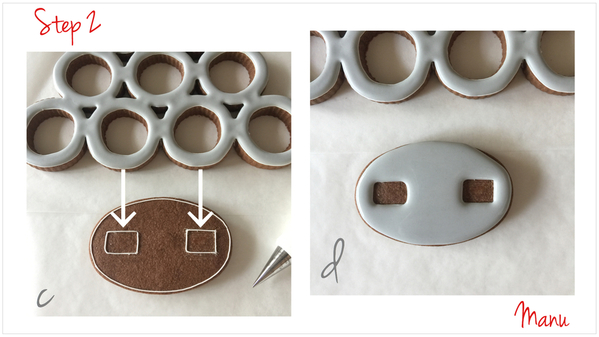
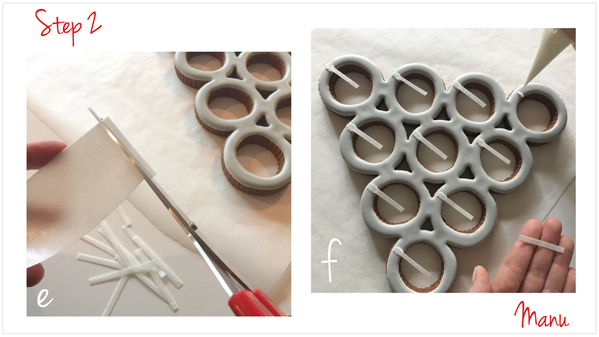



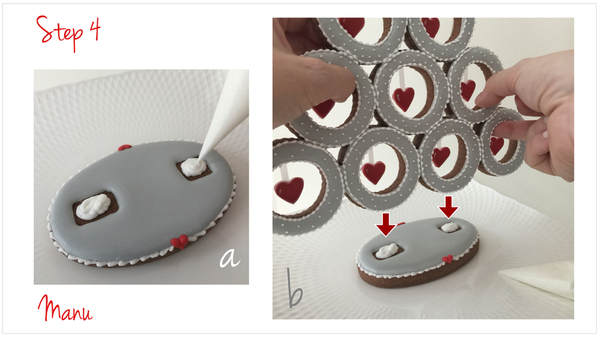

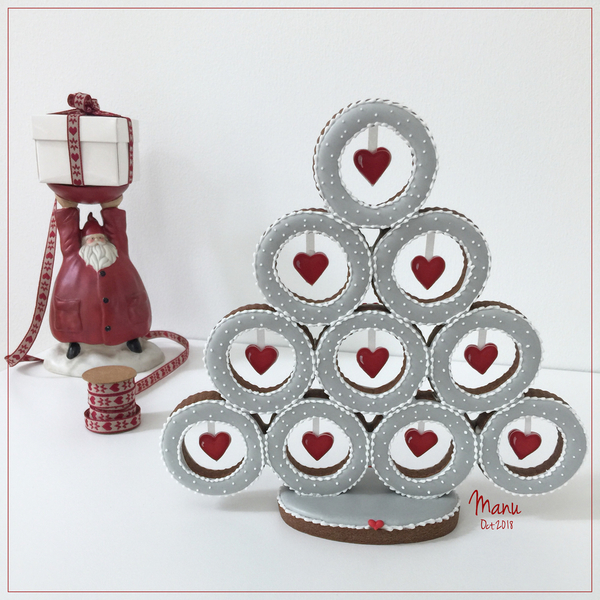
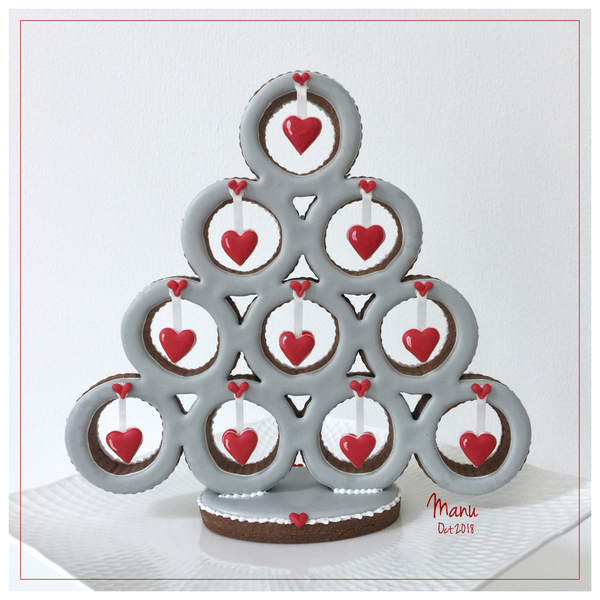
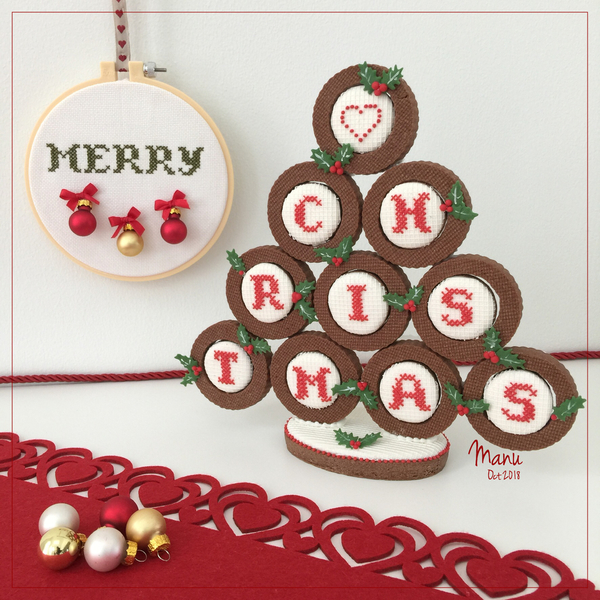

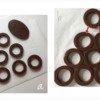




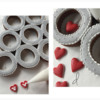

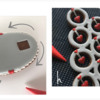

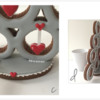



Comments (50)